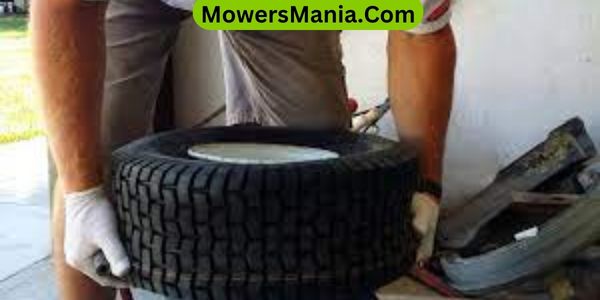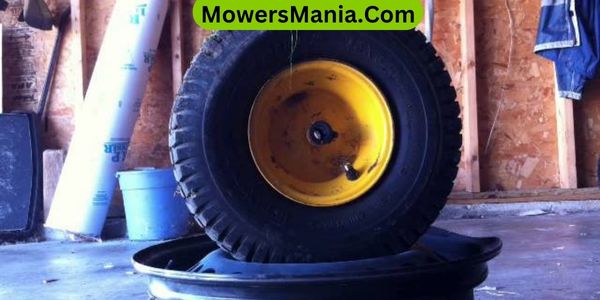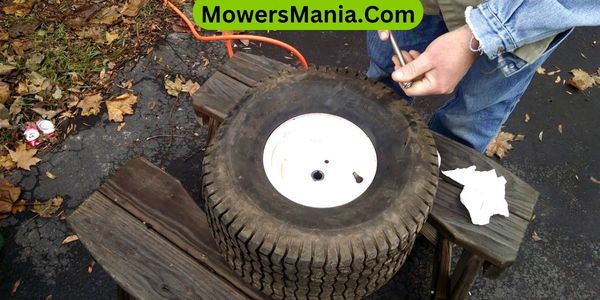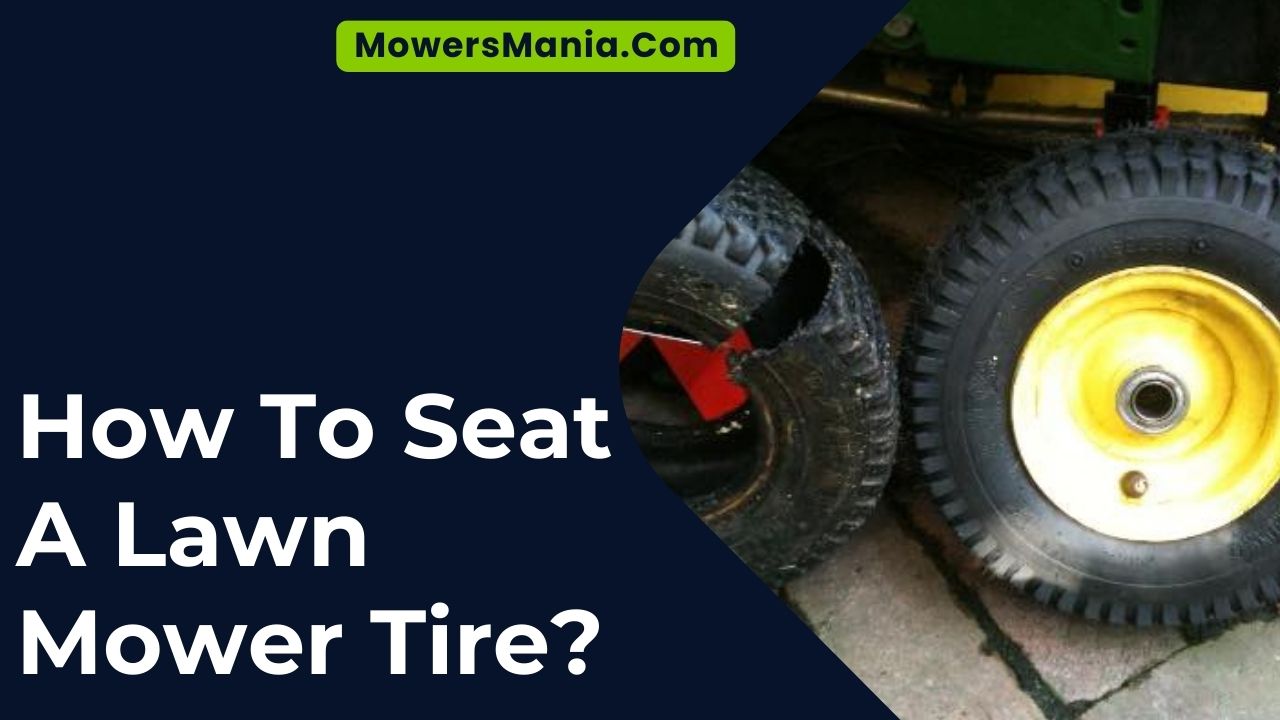If you’re struggling to seat a lawn mower tire, don’t worry – it’s easier than you think. With the right tools and a few simple steps, you’ll have your tire seated and ready to go in no time.
Just follow these instructions to remove the old tire, prepare the new one, and get it properly seated on the rim.

Once it’s inflated and tested, you’ll be back to mowing in no time.
Tools and Materials Needed
You’ll need a tire inflator with a pressure gauge for seating a lawn mower tire. This tool is essential for ensuring that the tire is inflated to the correct pressure, which is crucial for proper seating. Additionally, a pair of safety goggles and gloves are necessary to protect yourself from any potential injury during the process.
In addition to the tire inflator, safety goggles, and gloves, you’ll also need a spray bottle filled with soapy water.
This will help you identify any leaks once the tire is inflated. A small pry bar or tire iron will be required to help manipulate the tire onto the rim. It’s important to use caution and follow proper techniques to avoid damaging the tire or rim during this step.
Lastly, having a bucket of water or a large container to submerge the tire in can be helpful for locating leaks.
Submerging the tire and looking for air bubbles will indicate where any leaks are occurring. By having these tools and materials ready, you’ll be well-prepared to successfully seat a lawn mower tire.
Removing the Old Tire
To remove the old tire, first deflate it completely before proceeding further. Use a tire pressure gauge to ensure that the tire is entirely deflated.
After the tire is deflated, follow these steps to remove it:
- Lift the Mower: Use a jack or a sturdy platform to lift the mower so that the tire you’re removing is off the ground. This will make it easier to work on the tire and wheel assembly.
- Remove the Hubcap or Wheel Cover: If your lawn mower has a hubcap or wheel cover, carefully pry it off using a flathead screwdriver. This will give you access to the lug nuts that secure the wheel to the axle.
- Loosen and Remove the Lug Nuts: Use a lug wrench to loosen and remove the lug nuts that hold the wheel in place. Keep the lug nuts in a safe place, as you’ll need them when you install the new tire.
Preparing the New Tire

After removing the old tire, inspect the new tire for any damage or defects before proceeding with the installation.
Carefully examine the tread, sidewall, and bead of the tire to ensure there are no cuts, bulges, or other imperfections.
Additionally, check for any foreign objects such as nails or stones that may have become embedded in the tire during storage or transportation.
It’s crucial to address any issues before mounting the tire onto the lawn mower to prevent potential safety hazards and premature wear.
| Tire Inspection Checklist | Action |
|---|---|
| Tread | Check for even wear and depth |
| Sidewall | Look for bulges, cuts, or cracking |
| Bead | Inspect for any damage or irregularities |
| Foreign Objects | Remove any debris or foreign objects |
Completing a thorough inspection will give you peace of mind knowing that the new tire is in optimal condition for use. Taking the time to prepare the tire properly demonstrates your commitment to safety and ensures that your lawn mower will operate smoothly.
Seating the New Tire
Once you have thoroughly inspected the new tire for any damage or defects, proceed to seat it onto the lawn mower using the following steps.
- Lubricate the Bead: Apply tire lubricant to the bead of the new tire to make it easier to slip onto the rim. This will prevent any unnecessary stretching or damage to the tire during installation.
- Align the Tire: Position the tire onto the rim, ensuring that the valve stem aligns with the designated hole on the rim. It’s important to align the tire properly to avoid any issues with inflation and pressure.
- Use a Tire Iron: With the tire in position, use a tire iron to carefully lever the tire over the rim. Work your way around the tire, gently applying pressure to ensure it seats evenly onto the rim. Take care to avoid damaging the tire or the rim during this process.
Following these steps will help you properly seat the new tire onto your lawn mower, ensuring a secure and reliable fit for safe operation.
Inflating and Testing

Lubricating the valve stem area, you can then proceed to inflate the tire to the recommended pressure and conduct a thorough test for any leaks or irregularities.
Use a pressure gauge to ensure you reach the correct PSI (pounds per square inch) as specified in your lawn mower manual. Overinflating can lead to tire damage and reduce traction, while underinflating can cause poor handling and uneven wear.
Once inflated, visually inspect the entire tire for any signs of bulges, tears, or other damage. Next, submerge the tire in water or apply a soapy water solution to the valve stem and entire tread area. Look for bubbles, which indicate air escaping and potential leaks.
If bubbles appear, check the valve stem for proper installation and tighten if necessary. Additionally, inspect the rim and bead seating to ensure a secure fit.
Once the tire passes the leak test and appears free of irregularities, you can confidently mount it onto your lawn mower. Following these steps will help you ensure a safe and effective seating of your lawn mower tire.
Frequently Asked Questions [FAQs]
What Should I Do if the Tire Is Difficult to Seat Onto the Rim?
If the tire is difficult to seat onto the rim, try applying some soapy water to the rim and tire bead. This can help lubricate and ease the seating process. Use a tire iron to carefully work the tire onto the rim.
Can I Use a Lubricant to Help Seat the Tire Onto the Rim?
Yes, you can use a lubricant to help seat the tire onto the rim. It can make the process easier by reducing friction. Apply a small amount of lubricant to the tire bead and rim to assist with installation.
How Do I Know if the Tire Is Seated Properly on the Rim?
To know if the tire is seated properly on the rim, check for an even bead all the way around. Look for any gaps or unevenness. Also, make sure the tire is properly inflated.
Is It Normal for the Tire to Make a Popping Sound When Seating It Onto the Rim?
Yes, it’s normal for the tire to make a popping sound when seating it onto the rim. This occurs as the tire bead snaps into place. Ensure the tire is fully seated before inflating it.
What Should I Do if the Tire Continually Loses Air After Seating It Onto the Rim?
If the tire continually loses air after seating it onto the rim, check for any debris or damage on the rim or tire bead. Make sure the tire is properly seated and the valve stem is secure. If issues persist, seek professional assistance.
Conclusion
Now you know how to seat a lawn mower tire.
With the right tools and a few simple steps, you can easily remove the old tire, prepare the new one, and successfully seat it onto the rim.
Remember to inflate the tire to the recommended pressure and test it before using the lawn mower.
Happy mowing!



